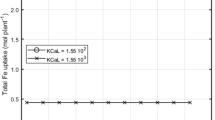Summary
The uptake of iron by wheat seedlings was investigated using half-strength Hoagland's nutrient solution containing 2.0 μM ferric chloride labelled with59Fe. The iron content of root tissue, which includes adsorbed iron, was depressed by the presence in the solution of the synthetic ligands EDTA and polymaleic acid (PMA) and by the natural ligands, humate, fulvate and a water-extractable soil polycarboxylate. The patterns of change in iron content of the shoots were in all cases different from those of the roots and were of two types. EDTA and humate increased the iron content of the shoots to maximum values, at ligand concentrations of 5.0 μM and 2.5 mg l−1 respectively, and decreased it at higher concentrations. Fulvate, water-extractable soil polycarboxylate and PMA increased the iron content of the shoots up to the maximum ligand concentrations tested (25 mg l−1). These results are discussed in the light of the likely solution chemistry of iron and the various ligands.
Similar content being viewed by others
References
Anderson, H. A. and Russel, J. D. 1976 Possible relationship between soil fulvic acid and polymaleic acid. Nature, London260, 597.
Barber, S. A., Elgawhary, S. M. and Malzer, G. L. 1972 Characterisation of nutrient supply mechanisms to plant roots using double labelling and the ratio of Ca/Sr absorbed, 11–20.In Proceedings of Symposium on the Use of Isotopes and Radiation in Research on Soil Plant Relationships. IAEA-FAO Vienna, Austria.
Burk, D., Lineweaver, H. and Horner, C. K. 1932 Iron in relation to the stimulation of growth by humic acid. Soil Sci.33, 413–435.
Chaney, R. L., Brown J. C. and Tiffin, L. O. 1972 Obligatory reduction of ferric chelates in iron uptake by soybeans. Plant Physiol.50, 208–213.
DeKock, P. C. 1955 Influence of humic acids on plant growth. Science121, 473–474.
Dormaar, J. F. 1975 Effects of humic substances from chernozemic Ah horizons on nutrient uptake byPhaseolus vulgaris andFestuca scabrella. Can. J. Soil Sci.55, 111–118.
Giesy, J. P. 1976 Stimulation of growth inScenedesmus obliquus (Chlorophycea) by humic acids under iron limiting conditions. J. Phycol.12, 172–179.
Glentworth, R. and Muir, J. W. 1963 The soils of the country round Aberdeen, Inverurie and Fraserburgh. Mem. Soil Surv. Gt. Br. (Scot). Edinburgh. H.M.S.O.
Hill-Cottingham, D. G. and Lloyd-Jones, C. P. 1965 The behaviour of iron chelating agents with plants. J. Exp. Bot.16, 233–242.
Hodgson, J. F. 1969 Contribution of metal-organic complexing agents to the transporting of metals to roots. Soil Sci. Soc. Am. Proc.33, 68–75.
Linehan, D. J. 1977 A comparison of the polycarboxylic acids extracted by water from an agricultural top soil with those extracted by alkali. J. Soil Sci.28, 369–378.
Linehan, D. J. 1978 Humic acid and iron uptake by plants. Plant and Soil50, 663–670.
Linehan, D. J. 1978 The uptake by plants of polymaleic acid: a polycarboxylic acid structurally related to those of soil. Plant and Soil50, 625–632.
Norvell, W. A. 1972 Equilibria of metal chelates in soils p. 115–138.In Mortvedt, J. J., Giordano, G. M. and Lindsay, W. L. (eds) Micronutrients in Agriculture. Soil Sci. Soc. Am. Madison.
Oertili, J. J. and Opoku, A. A. 1974 Effect of macronutrient ions on the availability of iron from a chelated source. Soil Sci. Soc. Am. Proc.38, 597–602.
Spiro, T. G., Allerton, S. E., Renner, J., Terzis, A., Bils, R. and Saltman, P. 1966 The hydrolytic polymerisation of Iron (III). J. Am. Chem. Soc.88, 2721–2726.
Spiro, T. G. and Saltman, P. 1969 Polynuclear complexes of iron and their biological implications. Struct. Bonding Berlin6, 117–156.
Stevenson, F. J. and Ardakani, M. S. 1972 Organic matter reactions involving micronutrients in soils p. 79–114.In Mortvedt, J. J., Giordano G. M. and Lindsay, W. L. (eds) Micronutrients in Agriculture. Soil Sci. Soc. Am. Madison.
Tiffin, L. O., Brown, J. C. and Krauss, R. W. 1960 Differential absorption of metal chelate components by plant roots. Plant Physiol.35, 362–367.
Wallace, A., Mueller, T. and romney, E. M. 1976 Excess EDDHA in the nutrient solution on iron uptake by bush beans. Comm. Soil Sci. Plant Anal.7, 93–96.
Author information
Authors and Affiliations
Rights and permissions
About this article
Cite this article
Linehan, D.J., Shepherd, H. A comparative study of the effects of natural and synthetic ligands on iron uptake by plants. Plant Soil 52, 281–289 (1979). https://doi.org/10.1007/BF02184566
Received:
Issue Date:
DOI: https://doi.org/10.1007/BF02184566




